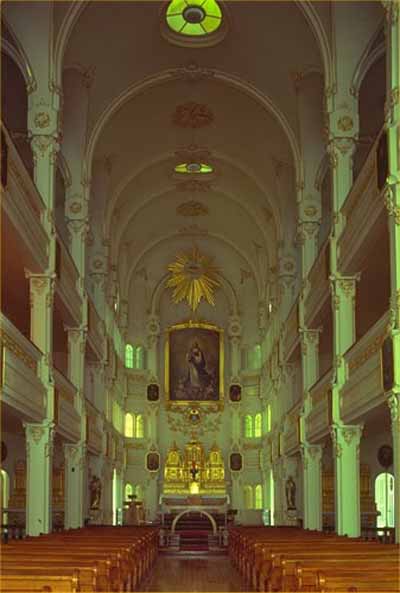Bon-Pasteur Chapel National Historic Site of Canada
Québec, Quebec

Interior of the chapel
© Parks Canada Agency/ Agence Parcs Canada, 1980.
Address :
1080 Lachevrotière Street, Québec, Quebec
Recognition Statute:
Historic Sites and Monuments Act (R.S.C., 1985, c. H-4)
Designation Date:
1975-11-28
Dates:
-
1866 to 1868
(Construction)
-
1875 to 1876
(Addition)
-
1909 to 1910
(Other addition)
Event, Person, Organization:
-
Charles Baillairgé
(Architect)
-
François-Xavier Berlinguet
(Architect)
Other Name(s):
-
Bon-Pasteur Chapel
(Designation Name)
Research Report Number:
1975-D
Plaque(s)
Existing plaque: 1080 Lachevrotière Street, Québec, Quebec
This chapel was designed in 1866 by the noted Québec architect Charles Baillairgé as part of a complex of buildings forming the mother house of the Sisters of the Good Shepherd of Québec. Although the exterior was rebuilt in 1909-1910, the interior design, with its strong vertical lines, double row of galleries and interplay of curves, still has a soaring beauty which encourages the spiritual contemplation intended by the original architect. This quality, along with the exceptional late 18th century carved altars, distinguishes the building as an outstanding example of church architecture in Québec.
Description of Historic Place
The Bon-Pasteur Chapel National Historic Site of Canada is part of a complex of religious buildings in the city of Québec. The chapel is a rectangular five-storey stone-faced building with a gable roof and is part of the motherhouse of the Sisters of the Good Shepherd, like the buildings flanking its sides. It is prized for its very fine interior designed by Charles Baillargé. Official recognition refers to the exterior and interior of the chapel on its footprint.
Heritage Value
The Bon-Pasteur Chapel was designated a national historic site of Canada in 1975 because it is an outstanding example of religious architecture in Québec.
The Bon-Pasteur Chapel, built between 1866 and 1868, was designed by the noted Québec architect Charles Baillairgé as part of a group of buildings forming the motherhouse of the Sisters of the Good Shepherd of Québec. The chapel was enlarged in 1909-1910 with a new façade designed by François-Xavier Berlinguet. The unaltered interior’s strong vertical lines, double row of galleries and interplay of curves lends emphasis to the calm, spiritual qualities intended by the original architect. This quality, along with the exceptional late 18th-century carved altars, designed by Pierre-François Baillairgé, distinguishes the building as a noteworthy example of church architecture in Québec.
Source: Historic Sites and Monuments Board of Canada, Minutes, November 1975.
Character-Defining Elements
The key elements that contribute to the heritage character of this site include: its prominent location situated between, and joined to, two wings of the Sisters of the Good Shepherd motherhouse; the rectangular, five-storey massing set under a gable roof; the stone-faced exterior; the original placement of doors and windows, including the arched windows and the round window; the formal composition of the interior in the classical style with its use of semi-circular forms in the doors and windows, and the curved partitions formed by rows of small, arcaded windows; the double galleries that run along each side and across the back of the chapel; the capitals and pillars featuring small paintings depicting the lives of the saints; the interior finish of white and gold with white scrollwork and plaster rosettes; the ornate main 18th-century altarpiece sculpted by Pierre and Noel Levasseur, the side altarpieces sculpted by unidentified sculptors, all three designed by Pierre-François Baillairgé at the end of the 18th century; the principal painting in the apse, conceived as part of the original design and signed by the well-known artist Antoine Plamondon, on the subject of the Immaculate Conception of the Virgin Mary.